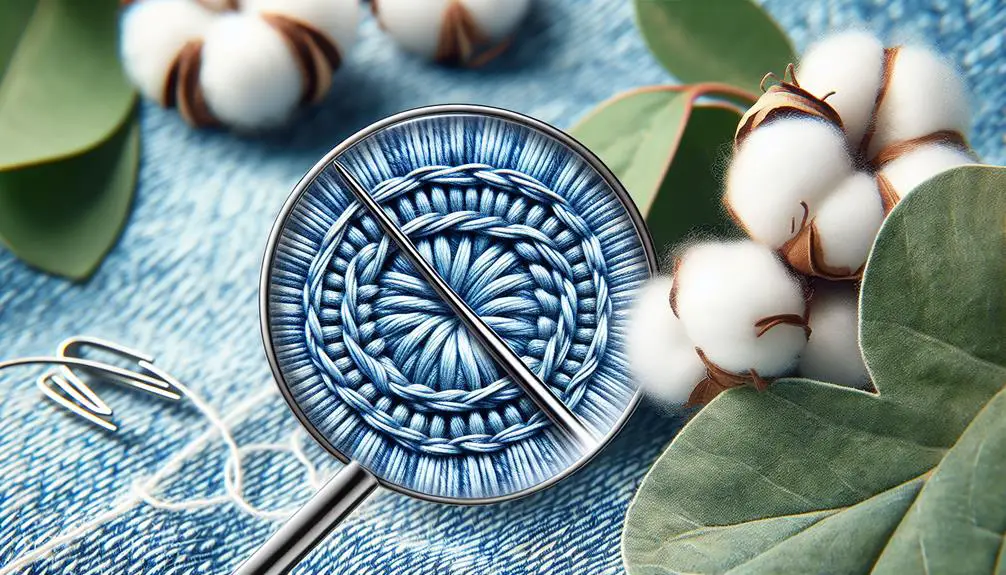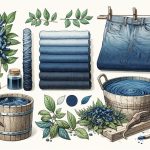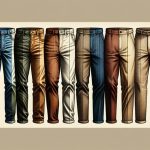Have you ever wondered why your favorite pair of jeans can take a beating and still look great? It's all about the denim. The secret sauce to denim's durability lies in its creation process, from the twill weaving technique to the high-quality cotton fibers used. This combination not only gives denim its distinctive look but also its unmatched toughness. And let's not forget the role of the indigo dyeing process, adding to its resilience. But there's more to it than just the materials and methods. Stick around, and I'll break down the fascinating details that make denim the go-to fabric for enduring style.
Table of Contents
Key Takeaways
- Denim utilizes a twill weave technique, enhancing its tear resistance and overall strength.
- The strength of denim significantly benefits from the resilience and durability of cotton fibers.
- Its weight and thickness contribute to denim's longevity, making it resistant to daily wear and tear.
- The quality of yarn, especially ring-spun and combed cotton, plays a vital role in making denim tougher.
- Indigo dyeing not only gives denim its characteristic blue color but also adds to its durability and strength.
The Weaving Technique
One key reason denim's so tough is its twill weave, which makes it way stronger than your average cotton fabric. This ain't just any weave; we're talking about a technique that cranks up the durability to eleven. See, in twill weave, the weft yarns cross over multiple warp yarns, creating this distinct diagonal pattern. It's not just for looks, though. This pattern is a big deal because it amps up the tear resistance and overall strength of the fabric.
What's more, those diagonal lines and ridges you feel on denim? They're not just there for texture. They play a huge role in making denim the go-to for anyone needing gear that lasts. It's like the fabric's got a built-in armor thanks to its weaving technique. And don't get me started on indigo dye – that's another layer to denim's tough-guy persona, but the twill weave's the real MVP here.
Long story short, the twill weave's what gives denim its muscle. It's the secret sauce behind why your denim can take a beating and come out looking even cooler. It's all about that strength, durability, and a bit of diagonal charm, making denim a true powerhouse in the fabric world.
Cotton Fiber Strength
While we've been talking up the twill weave, let's not forget that the strength of denim also heavily relies on its cotton fibers. These aren't your everyday, run-of-the-mill fibers; we're talking about a powerhouse ingredient that makes denim the go-to fabric for durability. Cotton fibers, by their very nature, are tough cookies. They bring their A-game to the denim fabric, giving it a resilience that's hard to beat. This isn't just about surviving a few washes. It's about withstanding the kind of wear and tear that would make lesser fabrics wave the white flag.
The quality of cotton used in denim can't be understated. High-quality cotton fibers mean your denim won't just last; it'll age gracefully, standing up to scrapes and friction like a champ. This durability is thanks in part to the twill weave, sure, but without sturdy cotton fibers, it wouldn't be nearly as effective. The combo of quality cotton and that clever twill construction is why denim can take a beating and come out looking better for it. It's a testament to the strength woven into every thread, making denim a fabric that's tough as nails.
Weight and Thickness
Diving deeper into what makes denim such a tough cookie, we can't ignore how its weight and thickness significantly boost its durability. When you pick up a pair of traditional denim jeans, you notice they're heavier. That's not by accident. This extra weight comes from the fabric's higher density and thickness, which, in plain terms, means it's built to last. We're talking about a material that's designed for the long haul, able to withstand frequent washing and hard wear without batting an eye.
The secret behind this? A higher thread count. More threads mean a thicker fabric, contributing to denim's ruggedness. It's this thickness that shields the fabric from getting easily worn out or torn. Denim doesn't just put up a fight against daily wear and tear; it's practically armored against it.
Yarn Quality Matters
When it comes to denim's toughness, the quality of the yarn plays a huge role. I've learned that not all cotton fabrics are created equal, and this truth is crystal clear in the denim world. Ring-spun yarn, for instance, is twisted tighter for that extra strength and durability we all love in our denim fabrics. It's like the difference between a well-knotted rope and a loosely braided one—the former just holds up better.
Then there's combed cotton yarn. This stuff goes through a combing process that not only makes it smoother but also stronger. It's like giving the yarn a workout, bulking it up to face the rough and tumble of daily wear. Plus, longer fibers in cotton mean stronger denim. It's a simple equation: longer fibers equal more durability. That's why selvage denim, known for its longevity, relies on high-quality yarn. It's all about getting those longer fibers woven into a twill weave that can take a beating.
Honestly, the textile industry's focus on yarn quality directly impacts the strength and durability of the denim we wear. It's a foundational thing. Without quality yarn, our denim just wouldn't stand a chance.
Indigo Dyeing Process
So, we're moving on to the indigo dyeing process, which is pretty fascinating.
I've noticed that indigo's unique properties not only give denim its signature look but also contribute to its durability.
Plus, there are so many ways to apply the dye, each affecting the final product in its own way.
Indigo's Unique Properties
Let's talk about how the indigo dyeing process not only gives denim its iconic blue shade but also embeds the fabric with unmatched durability and a unique fading charm.
When indigo dye penetrates deep into denim fibers, it creates those distinctive fading patterns that skyrocket the fabric's visual appeal. But it's not just about looks; this process ensures the denim holds onto its strength and durability, even after you've washed and worn it countless times.
The signature blue color isn't just for show; it's a hallmark of resilience and longevity in the fashion world. Denim dyed with indigo is a perfect blend of aesthetic appeal and robustness, making it a top choice for anyone looking for style that lasts.
Dyeing Technique Variations
Exploring the world of indigo dyeing, we find that not all techniques are created equal, each offering a unique touch to the denim's final look and durability.
Indigo dyeing isn't just about slapping color on cotton twill. This method is about depth. It penetrates deep into the twill weave, ensuring the indigo-dyed denim doesn't just wear down; it evolves.
The strength? It's unmatched. The durability? Through the roof. And those fading patterns? They're like a fingerprint—unique to each piece. This dyeing technique turns denim into more than fabric; it's a canvas that showcases a blend of strength and aesthetic appeal.
The result? Denim that lasts, telling its own story through every fade and wear mark.
Maintenance and Repairs
Caring for your denim properly, including regular maintenance and timely repairs, can significantly boost its longevity and keep it looking great. I've found that turning my jeans inside out before tossing them in the wash, and letting them air dry, really helps preserve the denim fabric's durability. It's not just about keeping them clean; it's about maintaining their shape, color, and that unique denim character we all love.
When it comes to repairs, I'm all for tackling them as soon as they come up. A small tear can quickly become a big problem if it's ignored. I've picked up a few DIY repairs tricks over the years, like using iron-on patches or simple sashiko stitching for a bit of flair. These methods not only extend the life of my denim but also add a personal touch.
I also swear by adding a bit of fabric conditioner to my washing routine. It's a game-changer for keeping my jeans soft without compromising their sturdiness. It's these small steps in maintenance and repairs that make all the difference, ensuring my denim stays in rotation for years to come.
Frequently Asked Questions
Is Denim the Most Durable Fabric?
I've always wondered if denim's truly the top dog in durability. Turns out, its twill weave, quality cotton, and special treatments like mercerizing make it super tough. But, it's not necessarily the most durable fabric around.
What Makes Jeans so Durable?
Jeans are super durable because they're made from denim, which uses a tough twill weave. The high thread count, tight weave, and strong cotton make them tear-resistant. Plus, special finishes boost their longevity.
How Durable Are Denim Jeans?
I've found denim jeans to be incredibly durable. They stand up to a lot of wear and tear thanks to the strong weave and quality cotton. It's why I always choose them for everyday wear.
What Is Special About Denim?
Denim's special because of its unique twill weave, making it incredibly strong. It's not just about looks; the high-quality cotton and tight weave mean my jeans can handle anything I throw at them.
- How Does Ring Spun Cotton Affect Garment Fit and Shape Retention? - August 13, 2024
- What Are the Challenges in Producing Ring Spun Cotton? - August 13, 2024
- Is Ring Spun Cotton Suitable for Plus-Size Clothing? - August 13, 2024







